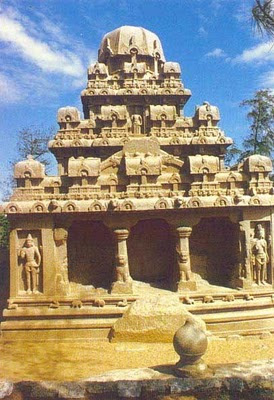


The city of Mahabalipuram is famous for its seashore which has an interesting group of ancient rock temples displaying the Dravidian style of architecture. The shore temples give a more ancient look and feel, older than they actually are, perhaps because of the wear and tear caused by the sea and brine.
This coastal town - is hot, humid round the year, but a treat to the eyes, mind and the shopper in you. If you are looking for a great photography expedition this is the place to get picture perfect shots. The shopper in you can revel in the multitude carvings and statutes. The main road is dotted with tiny tiny shops in a long row on either side of the road offering antiques in wood, stone and clay. Some pieces I came upon were truly heart stopping stunning! And indeed bought some too. Splendid sculptures. Beautiful statues made of granite stones. Handicrafts made of soapstone, sea-shell articles and jewelry to pine for. One needs time to explore, mull and decide on what one must buy. Time was a luxury I did not have this trip unfortunately.
It was during the rule of the Pallavas, many poets, dramatists, artists, artisans, scholars and saints emerged making the Pallavas the pioneers of new styles both in art and architecture. These creative energies reside to date in this small temple town especially when you see the multitude paintings on sale.
The spectacular beach of Mahabalipuram attracts thousands of tourists all through the year. The beach forever is crowded and packed with families literally lined shoulder to shoulder along the shores in their daily clothes as they wait for the water to rush up their legs while others escape the waves only to return for another bout. Either way, there is no end to the laughter as the sun sets and the ebb and flow draws nearer, it takes with it the memories of those who had enjoyed it as they part ways. There are other things to do while in Mahabs - a crocodile farm, snake venom extracting center, a school of art and sculpture, the annual dance festival among the many attractions for the tourists and travelers alongside the beach. Not surprising hence why tourists flock to Mahabs.
I was equally amazed to discover this place being a popular dating destination for many lovebirds. Most of them were in their private world of love and passion in corners, behind the rocks, in the trenches, and inside the caves declaring their undying commitment for each other. One such couple even approached me to take a picture of theirs on their mobile camera phone-while they melted into each others eyes.
The combination of beach and rocks AND the awesome monolithic structures makes Mahabalipuram very special. A day is simply not enough to explore this historical site. A return journey hence becomes a must. Mahabalipuram is barely an hour from Chennai, very very doable .




